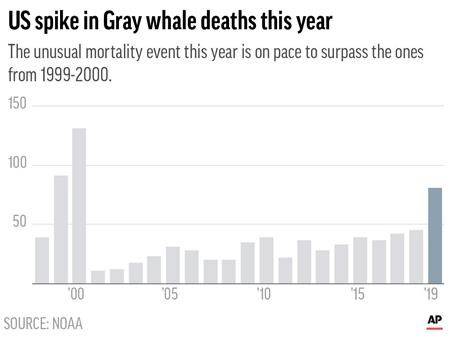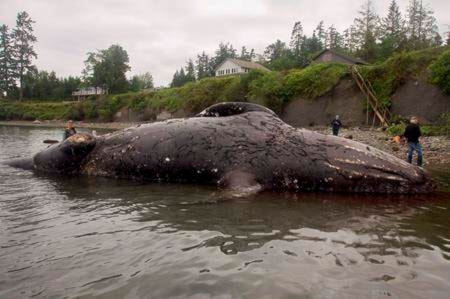So many grey whales are dying off the U.S. West Coast that scientists and volunteers dealing with the putrid carcasses have an urgent request for coastal residents: Lend us your private beaches so these ocean giants can rot in peace.
The number of dead whales washing ashore in Washington state alone — 29 as of this week — means almost every isolated public beach has been used. Authorities are now scrambling to find remote stretches of sand that are privately owned, with proprietors who don’t mind hosting a rotting creature that’s bigger than a school bus and has a stench to match its size.
“The preferred option is, at all times, that they just be allowed to decompose naturally,” said John Calambokidis, a research biologist with the Olympia, Washington-based Cascadia Research. “But it gets harder and harder to find locations where they can rot without creating a problem. This is a new wrinkle.”
At least 81 grey whale corpses have washed ashore in California, Oregon, Washington and Alaska since Jan. 1. If tallies from Mexico and Canada are added, the number of stranded grey whales hits 160 and counting, said Michael Milstein, spokesman for the National Oceanic and Atmospheric Administration’s fisheries office.
U.S. scientists last month declared the die-off an “unusual mortality event,” a designation that triggered additional resources to respond to the deaths and launch an investigation.
The first private-beach owners to respond, a Washington state couple, received their carcass earlier this month. Volunteers with the so-called “stranding network” — a coalition of nonprofits, research institutions and government agencies — attached a rope to the dead whale’s tail and used a motorboat to tow it 3 miles (4.8 kilometres) along the coast to the couple’s beach, where they anchored it to tree stumps.
Mario Rivera and his veterinarian wife, Stefanie Worwag, asked their neighbour’s permission first and are using copious amounts of lime to speed decomposition and reduce the stench. They visit the carcass daily and consider it a scientific opportunity.
“It’s decomposing nicely. There’ve been a couple of days this week when I was out there mowing and I was like, ‘Ooof,’” Rivera said of smell from the 40-foot (12-metre) adult male whale sitting 150 yards (137 metres) from his house.
“But it’s only temporary. It’s only going to be smelling for about a month — and after that, the smell’s gone.”
Since the Port Townsend, Washington, couple welcomed the carcass, 15 more private individuals have signed on to do the same, mostly in remote areas around the Salish Sea in far northwest Washington state, Milstein said.
The number of dead whales found in Washington state this year has already surpassed the tally for 2000, when the last significant die-off of grey whales occurred on the West Coast. In Oregon, five dead grey whales have been documented as of this week, more than in all of last year. California has seen 37, and 10 have come ashore in Alaska.
Experts estimate the washed-up whales represent just 10 per cent of the total number of the dead, with the rest sinking into the sea unnoticed by humans.
Gillian Flaccus, The Associated Press
Like us on Facebook and follow us on Twitter

